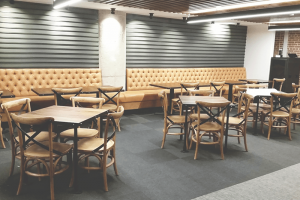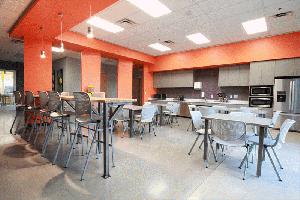How Employers Can Encourage Healthy Eating at Work
There’s a revolution taking place in today’s corporate cafeterias.
AUSTIN, TEXAS, USA, August 22, 2019 /EINPresswire.com/ -- How Did Office Cafeterias Go Gourmet?If we could go back 30 years to ask the question: “What’s your favorite office cafeteria or restaurant?” we probably would have gotten quite a few blank stares in response. Such was the state of affairs for the much-maligned office cafeteria in those days.
Someone might’ve suggested the United States Senate dining room at the Capitol in Washington, DC — where politicians, lobbyists, and reporters rubbed shoulders (wearing formal jackets and dresses of course, per the dress code). But, despite the high-power guests and Federalist decor, the menu selections were as uninspiring as the signature Senate Bean Soup, which has been on offer each day for more than a hundred years.
The situation today is altogether different. As we’ll see below, hardly a month goes by without a major announcement of a new corporate cafeteria opening up that rivals anything in the local restaurant scene.
But like most revolutions, this transformation didn’t happen overnight. To get where we are today took a journey of more than two decades, starting with a new cafe concept in the San Francisco Bay area.
If you’re thinking about Alice Waters and her groundbreaking Chez Panisse restaurant in Berkeley, you’re not far off. Waters has single-handedly helped develop the modern American palette and our appetite for eating locally grown food.
But there is another figure who helped transform the lackluster world of corporate and institutional cafeterias into the modern gourmand era, the restaurant entrepreneur Fedele Bauccio.
Larry Ellison, the co-founder of the software database giant Oracle, gave Bauccio his first big break in the corporate catering world of Silicon Valley, selecting his company to create a paninonteca, or Italian sandwich shop. Soon Bauccio’s company, Bon Appetit Management Company, opened a series of different cafe offerings at Oracle, each featuring a different cuisine.
Over time, Bon Appetit’s concept of providing high-quality, locally-sourced food took root all across Silicon Valley. The company now operates more than 500 corporate cafeterias at leading tech companies, including Adobe, eBay, Google, LinkedIn, and Yahoo. At Google’s Mountain View headquarters alone, Bon Appetit operates more than 30 different cafes.
The Top 5 Reasons You Should Introduce Healthy Food Options In Your Office
Is the trend toward upgrading corporate cafeterias on your radar?
We look at five reasons you might want to make the switch to offering healthier food options in the office.
1. Cafeterias That Support Your Brand Message Are Becoming An Essential Talent Recruiting Tool
Given the ongoing shortage of tech talent, leading tech and finance companies are making an investment in cafe amenities to build up their brand as a cool place to work.
The resulting transformation of the once mundane corporate cafeteria into a “must try” food destination hasn’t gone unnoticed in the culinary, restaurant, and food service industry, as this deep dive article by Bon Appetit (the magazine, not Fedele Bauccio’s company!) explains:
“Where boomers were swayed by sturdy 401-k plans and reliable retirement packages, today’s labor force—particularly those interested in tech-y and internetty jobs—are wooed by snacks, sustainability, and farm-to-cubicle ethics. And these companies are happy to keep them at the office longer, both in the span of a day and the span of a career.”
In other words, Millennials and Gen Z employees prefer to start their careers at companies that cater (pardon the pun) to their needs and desires, which skew toward workplaces with college campus-inspired open office environments, sustainable business practices, and healthy food choices.
Among these aspirations, it’s the latter one, healthy food choices, that often winds up as the most talked about amenity shared among their peers on social media. Indeed, Instagrammable food pics send a signal to their friends and followers (who, in turn, represent a significant pool of potential job recruits) that company X, Y or Z “is a cool place to work, just look at the food! #delicious.”
2. Skip Sad Desk Lunches. Use Mealtimes To Converse And Collaborate With Colleagues At Work
In a world where we are trying to kick-start worker productivity by encouraging spontaneous collaborations, corporate cafeterias offer a unique opportunity to connect with your co-workers while you savor your meal.
By investing in a central eating location, companies can avoid the food diaspora that occurs at lunchtime. At lunchtime, a certain percentage of employees head for the exits to partake in a longish lunch at some local establishment, while another group hovers worryingly around the kitchen mess, waiting for their moment to get a chance to heat up their salty microwave meal before they muddle through another “sad desk lunch.”
What a missed opportunity.
If you are concerned about lack of communication and missed opportunities for collaboration among your employees, then you should consider an investment in a new or upgraded cafeteria.
It can also help improve productivity by reducing those “long lunches” off campus. A recent study by Towers Watson indicates that having food available at work can save employees between 30 and 60 minutes at lunchtime.
Not sure how to go about it? Talk to one of our friendly Formaspace Office Design Consultants who will share their experience of creating cafeteria furniture for leading companies, such as CapitalOne and Twitter.
3. Good Nutrition Is A Cornerstone Of Good Employee Health
Companies have a reason to be concerned about their employee’s health, particularly due to the alarming increase in incidences of obesity and diabetes that are affecting American workers.
Increasing the activity of your workers at the office is part of the solution.
Getting up and moving around during the day is important; in fact, the negative health aspects of sitting for hours at a time has given rise to the phrase “Sitting is the New Smoking.” That’s why we recommend taking a look at our line of Sit-to-Stand desks, workstations, and conference tables. These innovative furniture designs allow you to change your seating position during the day, from sitting in a chair to standing, in order to improve your cardiovascular health. Taking breaks and walking throughout the day is also part of the solution, including taking a walk to the cafeteria.
Having a cafeteria on site is another way to help your employees live a healthier lifestyle.
Onsite cafeterias will encourage your employees to eat regular meals throughout the day. Research shows many Americans skip meals entirely during the workday. Serving proper portions of healthy food on a regular time schedule can help prevent/control obesity and diabetes.
You can also help “nudge” employees to avoid excessive calories by offering smaller plate sizes (which make us feel fuller with the same caloric intake) as well as changing the menu and recipe choices.
Consider reinforcing healthy eating choices in the cafeteria with other wellness programs, such as an onsite gym or workout facility.
For many employees, using a fitness app, such as MyFitnessPal, LoseIt or FitBit, can help reinforce calorie control and encourage a healthy, active lifestyle.
4. Rethink Food Offerings To Provide Healthier, More Sustainable Options
Companies like Google are taking the concept of calorie control a step further.
For example, the recipe for hamburgers offered at their cafeterias has slowly shifted to include more plant-based ingredients, such as mushrooms.
And healthier vegan choices are promoted more prominently on menus to encourage eating less meat.
It’s all part of Google’s overall plan to reduce the company’s impact on the planet by reducing consumption of livestock, dairy, and egg production that contributes to global carbon emissions.
What can you do at your company?
From birthday cakes to pizza parties, the office makes it difficult for individuals to control calories and make good nutrition choices. One place to start is by replacing sugary and high-caloric snacks with healthy alternatives. Phase out cakes and “treats” with healthy alternatives that have less sugar and more nutrient content. Eliminate pastries and other “treats” provided during long office meetings with healthy alternatives based on fruit and vegetables.
What about snacking throughout the day?
Snacking is not inherently bad. In fact, some nutritionists recommend we eat many smaller mini-meals throughout the day rather than two or three big meals. But we need to eliminate the temptation of sugary late afternoon snacks. Swap out the vending machine and replace it with healthy snack choices.
What if you don’t have a cafeteria at your office?
If you don’t have an office cafeteria, you can organize healthy potlucks where people bring healthy food options from home. For example, a salad club encourages each participating person to bring a special salad topping or side dish.
5. Teach Gardening, Food Preparation, And Cooking Skills For A Healthier Lifestyle At The Office And In The Community
Companies like Adobe and Google are now going beyond just providing healthy food in the cafeteria — they are using their kitchens as teaching tools to educate their employees about the food we eat.
Employees can participate in cooking classes taught by corporate chefs in specially designed kitchens that mimic the type of residential kitchen the employees have at home. These classes go beyond just recipes, they include learning about where food comes from (especially locally-sourced produce), how to be an educated food shopper, and, of course, how to cook healthy recipes at home.
This is an important effort, because many of today’s workers are very disconnected from food sources, instead, relying on pre-packaged, highly processed foods.
Companies can help by partnering with a local community garden, participating in farmer “shares” programs, or arranging buying trips to local farmer markets.
Programs such as these encourage your employees to become healthy food advocates in the communities where they live. You can reinforce this message by offering healthy food from your company garden to visitors and partner companies attending meetings at your facilities.
Read more ... https://formaspace.com/articles/education/best-architecture-design-schools-in-usa/?utm_source=einpresswire&utm_medium=content&utm_campaign=article-070518
Mehmet Atesoglu
Formaspace
22792792
email us here
Meet Bon Appétit Management Company




